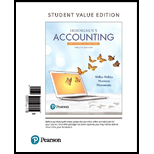
1)
Journal:
Journal entries record the effect of the financial transactions on impacted accounts and assist in preparation of financial statements.
Accounts are debited to increase balances of assets and expenses and credited increase the balance of incomes and liabilities
To Prepare:
Journal Entries for November and December 2018.
2)
T- Account
It is a graphical representation of the postings made to the accounts during a reporting period.
It helps in analysis of the transactions impacting the accounts.
To Prepare:
T-Accounts for each of the entries.
3)
T-Account:
It is a graphical representation of the postings made to the accounts during a reporting period. It helps in analysis of the transactions impacting the accounts.
To indicate:
Posting to T-Accounts
4)
A trial Balance is a list of the balances of various Assets, Liabilities, Expense and Revenue Accounts. It helps in evaluating the arithmetical accuracy of financial transactions and postings during a reporting period and serves as the starting point in the preparation of financial statements.
To prepare:
Trial Balance as at 31 December 2018
5)
Financial Statements of an Entity
Financial Statements are financial records of the entities transactions for a given reporting period and indicate the financial health of an entity. They comprise of:
1. Income Statements,
2. Balance Sheets and,
3.
Prepare Income Statement for the year ended 31 December 2018.
6)
Statement of Owner’s Equity.
A statement of owner’s equity is a representation of all the capital introduced and withdrawn during a particular reporting period. It also represents the closing balance of the capital invested in a business.
To prepare:
Statement of Owner’s Equity for the year ended 31 December, 2018,
7)
Financial Statements of an Entity
Financial statements are financial records of the entities transactions for a given reporting period and indicate the financial health of an entity. They comprise of:
1. Income Statements,
2. Balance Sheets and,
3. Cash flow statements.
Balance Sheets list the closing balances of assets and liabilities after giving effect to the operations for a reporting period. Assets and liabilities are grouped together based on their nature and life.
To prepare:
Balance Sheet as at 31 December, 2018.
8)
Debt Equity Ratio
It is a measure of the proportion of how much debt has been used to finance the equity and operations of the business.
The lower the ratio the better. Higher Debt equity ratio represents a highly leveraged business and can also indicate higher interest payments and lower profitability.
The Debt Ratio for the year ended 31 December 2018.
Want to see the full answer?
Check out a sample textbook solution
Chapter 2 Solutions
Horngren's Accounting, The Financial Chapters, Student Value Edition Plus MyLab Accounting with Pearson eText - Access Card Package (12th Edition)
- What Is the equity at the end of the year?arrow_forwardWhat was mark jons beginning capital balance?arrow_forwardFor questions 6 and 7, refer to the following information from the balance sheets and income statement of Pink Corp. From the balance sheets 12/31/2024 12/31/2023 Accounts receivable Prepaid insurance Machines Acc. depreciation $90,000 8,000 $80,000 From the income statement 12/31/2024 Sales $750,000 12,000 Cost of sales 65,000 95,000 Operating Expenses -600,000 -75,000 -30,000 -20,000 Gain on sale of machine 4,000 Additional information: Operating expenses includes depreciation expense Machines costing $30,000 were sold for $22,000 at a gain. 6) How much would net income be adjusted under the indirect method? A B $(12,000) $12,000 с D $0 $20,000 7) What were the cash payments for operating expenses under the direct method? A $74,000 C $61,000 B $49,000 D $53,000arrow_forward
- Solve this general accounting problem?arrow_forwardThe owner's equity at the beginning of the period for Vivo Enterprises was $52,000. At the end of the period, assets totaled $110,000, and liabilities were $28,000. If the owner made an additional investment of $12,000 and withdrew $9,000 during the period, what is the net income or (net loss) for the period?arrow_forwardAnswer me these problemsarrow_forward

 AccountingAccountingISBN:9781337272094Author:WARREN, Carl S., Reeve, James M., Duchac, Jonathan E.Publisher:Cengage Learning,
AccountingAccountingISBN:9781337272094Author:WARREN, Carl S., Reeve, James M., Duchac, Jonathan E.Publisher:Cengage Learning, Accounting Information SystemsAccountingISBN:9781337619202Author:Hall, James A.Publisher:Cengage Learning,
Accounting Information SystemsAccountingISBN:9781337619202Author:Hall, James A.Publisher:Cengage Learning, Horngren's Cost Accounting: A Managerial Emphasis...AccountingISBN:9780134475585Author:Srikant M. Datar, Madhav V. RajanPublisher:PEARSON
Horngren's Cost Accounting: A Managerial Emphasis...AccountingISBN:9780134475585Author:Srikant M. Datar, Madhav V. RajanPublisher:PEARSON Intermediate AccountingAccountingISBN:9781259722660Author:J. David Spiceland, Mark W. Nelson, Wayne M ThomasPublisher:McGraw-Hill Education
Intermediate AccountingAccountingISBN:9781259722660Author:J. David Spiceland, Mark W. Nelson, Wayne M ThomasPublisher:McGraw-Hill Education Financial and Managerial AccountingAccountingISBN:9781259726705Author:John J Wild, Ken W. Shaw, Barbara Chiappetta Fundamental Accounting PrinciplesPublisher:McGraw-Hill Education
Financial and Managerial AccountingAccountingISBN:9781259726705Author:John J Wild, Ken W. Shaw, Barbara Chiappetta Fundamental Accounting PrinciplesPublisher:McGraw-Hill Education





